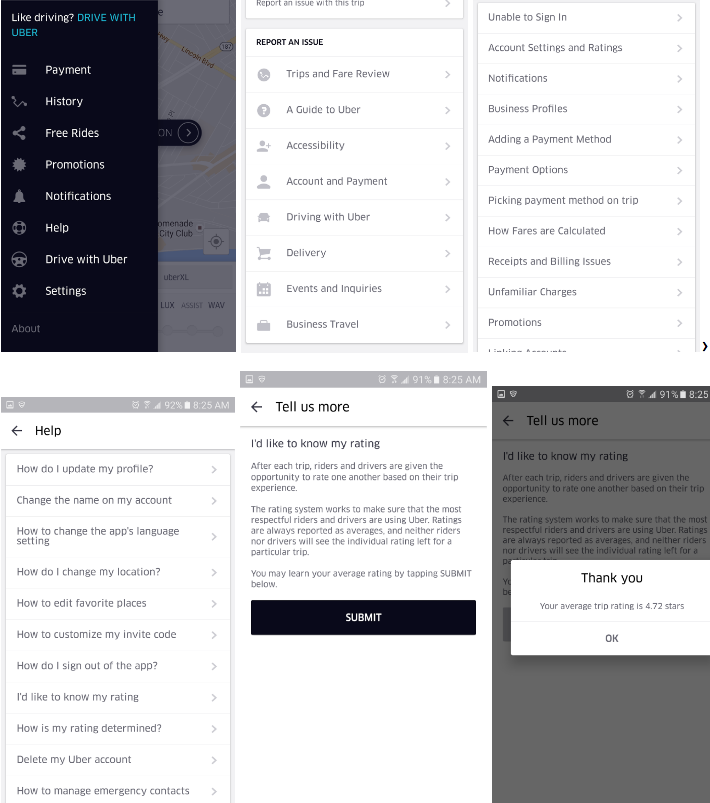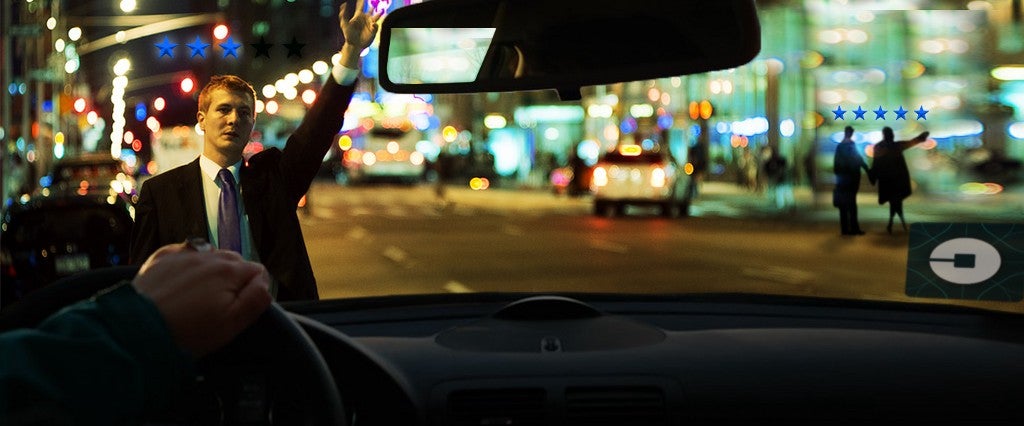Uber’s mysterious passenger rating system, which allows drivers to rate their customers in the same way you rate your driver, has taken on a sort of mythic quality since its existence first became known. Considering how widely the topic has been covered, the number of regular Uber users who are unaware they’re being rated by their drivers is astounding: Bring up the topic with friends and you’ll be treated to the sight of at least two of them diving for their phones.
This intrigue is fueled in part by the circuitous route necessary to find your rating, which goes as follows:
- From the drop down menu in the top left of the screen, choose “Help”
- From the next menu, choose “Account and Payment”
- From the next menu, choose, “Account Settings And Ratings”
- From the next menu, choose “I’d like to know my rating”
- When the prompt appears, hit “Submit”
It looks (somewhat) straightforward written out like that, but when faced with the seemingly endless options on each menu screen, the path is far from obvious.

Still, it’s worth figuring out. While a bad rating won’t automatically disqualify you from using the app, a slew of one- or two-star ratings could be enough to leave you stranded while everyone else gets a car with ease.
There’s no strict set of rules in place to determine what gets you a bad score, but plenty of seemingly innocuous actions will do the trick. An Uber spokesperson explained that something as simple as asking to be picked up on a busy street or somewhere difficult to park could ding your score. Trying to pile more than four people into a standard UberX will definitely do it, according to the spokesperson, and eating or drinking without the driver’s permission is an invitation for a bad review as well. Basically, anything that causes your driver hassle — or more importantly, costs them money by wasting their time — could lead to your score dropping. In other words, it’s always best to make sure you’re waiting exactly where you put the pin when your driver arrives.
As with any review system, the motivations for giving a bad score can vary wildly from driver to driver, so much so that even some drivers question the system’s practicality. It’s similar to the way many regular Yelp users ignore any one-star review (most likely someone blowing off steam after a bad day) or any five-star review (most likely the business owner, her family and her friends).

“In the beginning, if someone had a bad rating, I figured an issue was probably going to come up,” says Ara, an Uber driver in L.A. who has spent the last two years behind the wheel. “What I’ve learned since is that a lot of drivers give a client a bad rating just because they’re going a short distance. That’s why I don’t look at the ratings anymore.”
Many passengers, of course, are just as thoughtless when submitting their own reviews. “I’ve gotten bad ratings for traffic,” explains Ara. “They think it’s my fault! They think I’m not avoiding it so I get paid more. But it’s 15 cents per mile, and no driver wants to sit in traffic for 15 cents a mile. I hate to sit in traffic, just like every other Uber driver.”
The consequences for an Uber driver whose rating dips — even a little — are severe. “If your rating goes below 4.7 and stays like that for two weeks, you get deactivated,” says Ara. “Then you have to take classes to prove you can do better. I’ve never been in the class! My rating is a 4.9…”
There’s a nuclear option for dealing with crappy passengers, too: In what Uber’s website describes as a “cooling off period,” any user who really pisses off a driver can be blocked from the app entirely. This is what L.A. resident Harry Dilsmore believed had happened to him after his Uber app failed to load for more than a month. It eventually turned out to be a glitch, but his paranoia was well-founded: Two weeks before the app went offline, a driver warned him about his terrible score. “I stepped into a car to find the driver shaking his head, chuckling,” Dilsmore says. “I asked him what he was laughing at, and he goes, ‘You haven’t seen your Uber rating, have you?’ He was just giggling to himself. But he refused to tell me what my rating was!”
According to Uber, deactivation can only happen following a specific complaint by a driver, rather than as a result of a generally low rating, and you will definitely be notified. “If an incident occurs with a rider that warrants deactivation, a rider will get notified that their account has been deactivated,” says the Uber spokesperson. “If the rider has any questions, they can reach out to Uber support for more information.”

Rating and reviewing have been core parts of the sharing economy since its inception. The system has no doubt proved useful in weeding out some bad apples — businesses and customers — but entrusting such power to the general public comes with an obvious set of problems. As anyone who’s ever been on the internet knows, reason has no place in such things, and the merest unintentional slight has the potential to trigger a wildly disproportionate response.
“The whole sharing economy is going to go through some adolescence,” says Dilsmore, recounting the tale of a friend who rented out her home on Airbnb and received a negative review from one guest simply because the bathroom didn’t have a towel bar. “It had towel hooks!” laughs Dilsmore. “But because this person wanted a bar, not hooks, my friend’s five-star rating got cut in half.”
It’s no joke for those who make a living renting out their homes. A five-star rating is vital for people looking to keep their rental pad regularly occupied, and it can be lost to any minor whim. In fact, the capricious nature of online commenting was enough of a concern for HomeAway — the vacation rental giant that owns VRBO and BedAndBreakfast.com — to include built-in safeguards when it launched its own guest-rating system for owners earlier this year.
“At the end of the stay, both the owner and the traveler are prompted to write a review,” says Jordan Hoefar, corporate communications manager for HomeAway. Only after each party has submitted their review — or a 14-day period has passed and one party has declined — will the reviews be published. (Airbnb uses a similar system.) “That way it’s honest and unbiased,” Hoefar explains. “You don’t want a situation where a traveler had a negative experience with their home, and so just out of spite, the owner writes a negative review of that traveler.”

This doesn’t stop people from giving bad reviews for other pointless reasons, but it does at least — in theory — help prevent reviewer flame wars. “Our policy is to make sure people are writing and describing things that are a matter of fact,” says Hoefar. “We don’t want to get into disparaging comments where things are getting very personal.”
Back on the road, Uber’s biggest rival, Lyft, also has a robust passenger-review system in place, albeit with a few minor differences. “There isn’t a specific threshold [for getting blocked from using the Lyft app],” says Lyft Communications Manager Paige Thelen. “But if we constantly receive negative feedback about passenger behavior, we will reach out to the passenger to alert them of their low rating so they’re aware that they’re at risk of being removed from the platform.”
The biggest difference between Uber and Lyft’s rating systems is that, these last-minute warnings aside, there’s no way to discover your rating on Lyft by yourself, and according to Thelen, there are no plans to change this in the future.
In fact, neither Uber nor Lyft offered an explanation for why their ratings are so hidden. This, really, is where the system fails to live up to its potential — after all, what good is a rating system so secretive (or so buried in menu options) that those being rated can’t learn from their mistakes? Isn’t the purpose of any review to encourage the subject to try a little harder next time?
“Not all passengers know that they have a rating — that’s an issue,” says Ara. “If people knew about this, they might behave a little better.”
Whether transparent or not, it’s likely we’ll see more and more companies adopting similar review systems, with the end goal far beyond just weeding out potential troublemakers. Experts predict that within the next five years, all of these reviews will be aggregated and shared between brands, the information analyzed by their stat teams and used to target potential new customers based on their past conduct — each review scoured for patterns of positive behavior as brands try to woo those who fit their ideal customer profile.
When companies begin to incentivize this positive customer behavior, we may well start consciously trying to make ourselves more appealing to brands, a reversal of the traditional relationship. The future of commerce is here, and it expects us to behave.

